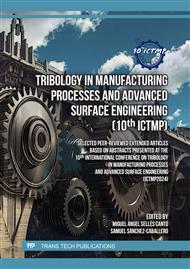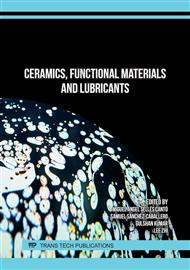p.63
p.71
p.79
p.87
p.97
p.107
p.117
p.125
p.133
Temperature Sensing in Cold Forging with Thermochromically Enhanced Lubrication Systems
Abstract:
Cold forming is characterized by high dimensional and shape accuracy as well as energy and cost efficiency in the series production of highly stressed components. Cold forming is characterized by high tribological loads. Complex lubrication systems are necessary to ensure fault-free production despite the high tribological loads. In the course of increasing demands on environmental compatibility, the disadvantageous zinc-phosphate-based lubricant systems have been replaced by more environmentally friendly single-layer lubricant systems. However, their functionality is strongly dependent on temperature, so that exact knowledge of the prevailing temperatures in the forming zone is necessary for optimum design of the lubricants [1]. Due to the high tribological stress, established measuring methods based on thermocouples can only approach the forming zone up to 10 mm. Previous works of the authors have shown that sensory lubricants based on thermochromic indicators are in principle capable of measuring temperatures directly in the forming zone [2,3]. Their functionality is based on the irreversible color change as a function of temperature [4]. The aim of this study is to develop a standardized test methodology for calibrating the sensory lubricants, which enables an exact correlation between temperature and color value. In addition, suitable indicators are to be identified and their influence on the tribological system analyzed. The test methodology developed uses inductive heating to heat the samples coated with the sensory lubricant to as high as 500 °C within 1 s. The temperature of the surface is determined by the temperature of the lubricant. By determining the surface temperatures reached as well as the color values under diffuse illumination in an integrating sphere, defined temperature ranges can be assigned to the color values of the indicators. With three indicators, which were identified as suitable, it was possible to detect temperatures in the contact zone of a full forward extrusion process and in the contact zone of the sliding compression test that reflect the simulated temperatures. In addition, the sliding compression test showed that the indicators have no influence on the tribological system up to an indicator concentration of 4 %.
Info:
Periodical:
Pages:
117-124
Citation:
Online since:
March 2025
Authors:
Keywords:
Price:
Сopyright:
© 2025 Trans Tech Publications Ltd. All Rights Reserved
Share:
Citation:



